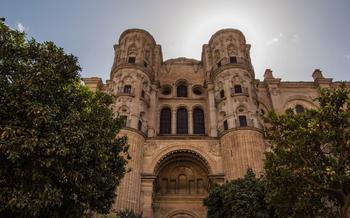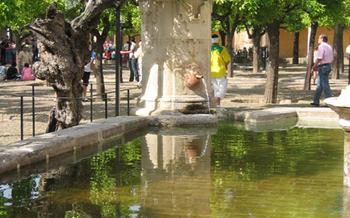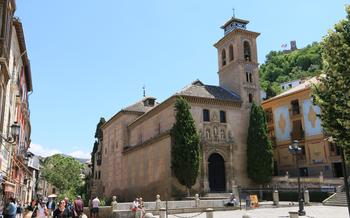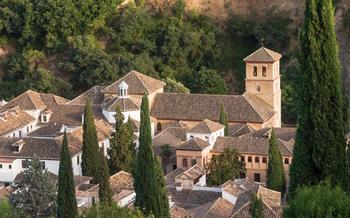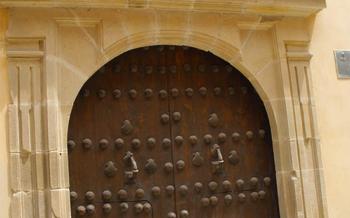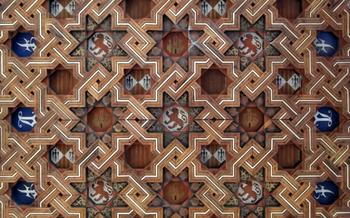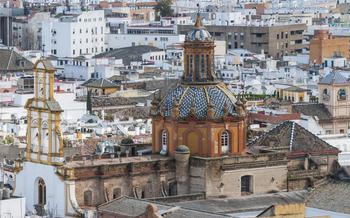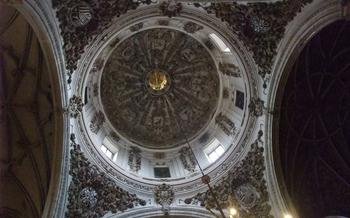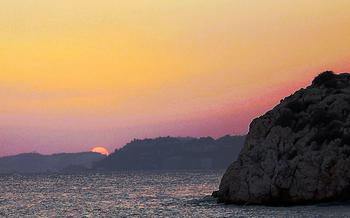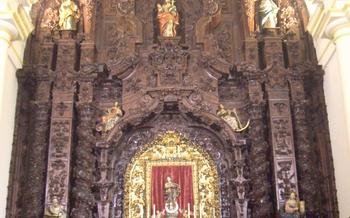
Basilica of Santa Maria de la Victoria
- Baroque Architecture: A Masterpiece of Faith and Art
- History and Origins
- Architectural Marvel
- Distinctive Facade and Twin Towers
- Blend of Architectural Styles
- Octagonal Dome
- Interior Layout and Use of Light
- Artistic Treasures
- Religious Significance
- Visiting the Basilica
- Location and Transportation
- Hours of Operation
- Admission Fees
- Guided Tours
- Accessibility
- Photography and Videography
- Souvenirs and Gifts
- Local Cuisine and Dining
- Insider Tip
Baroque Architecture: A Masterpiece of Faith and Art
The Basilica of Santa Maria de la Victoria stands as a testament to Malaga's rich history and artistic heritage. Constructed in the 16th century under the patronage of the Catholic Monarchs, this Baroque masterpiece is a fusion of architectural influences that showcases the city's devotion to its patron saint, Christ of the Victory.
The basilica's facade is a symphony of intricate carvings, featuring biblical scenes and figures of saints. The twin towers, reaching towards the sky, symbolize the basilica's spiritual aspirations. Stepping inside, visitors are greeted by a breathtaking spectacle of Baroque splendor. The octagonal dome, a defining feature of the basilica, floods the interior with natural light, illuminating the ornate frescoes and sculptures that adorn every corner.
Among the basilica's artistic treasures is the revered statue of Christ of the Victory, a masterpiece by the acclaimed sculptor Pedro de Mena. This life-size wooden sculpture, created in the 17th century, portrays Christ in a moment of triumph, holding the cross as a symbol of victory over death. The statue's realistic details and expressive countenance evoke a profound sense of devotion, drawing pilgrims from all over the world.
History and Origins
The Basilica of Santa Maria de la Victoria holds a significant place in the history of Malaga and the Catholic faith. Its construction was initiated in the 15th century under the patronage of the Catholic Monarchs, Ferdinand and Isabella, who played a crucial role in the Reconquista of Spain from Muslim rule. The basilica was built on the site of a former mosque, symbolizing the triumph of Christianity over Islam.
The architectural design of the basilica reflects the transition from Gothic to Renaissance styles, with influences from both periods evident in its structure and ornamentation. Over the centuries, the basilica underwent several modifications and additions, each contributing to its unique architectural identity.
Throughout its history, the basilica has been associated with numerous historical events and legends. One notable story involves the miraculous appearance of the Christ of the Victory statue, which is believed to have occurred during the battle of Lepanto in 157The victory of the Christian fleet against the Ottoman Empire is attributed to the intercession of the Virgin Mary and the Christ of the Victory, solidifying the basilica's reputation as a sacred site.
Architectural Marvel
Distinctive Facade and Twin Towers
The Basilica of Santa Maria de la Victoria stands out for its captivating facade, characterized by two striking twin towers that soar high above the city skyline. These towers, adorned with intricate carvings and delicate pinnacles, are a testament to the remarkable craftsmanship that went into the basilica's construction. The main entrance, set between the towers, features an impressive archway topped with a beautiful rose window, adding to the overall grandeur of the facade.
Blend of Architectural Styles
The basilica's architectural style is a harmonious blend of Gothic, Renaissance, and Baroque elements. The Gothic influence is evident in the pointed arches and ribbed vaults that grace the interior, creating a sense of height and grandeur. Renaissance elements, such as the classical columns and pilasters, lend an air of elegance and sophistication to the basilica's design. The Baroque style, with its characteristic ornamentation and elaborate details, is showcased in the intricate carvings, sculptures, and decorative elements that adorn the exterior and interior of the basilica.
Octagonal Dome
A notable feature of the Basilica of Santa Maria de la Victoria is its octagonal dome, which crowns the transept crossing. The dome, adorned with colorful tiles and intricate patterns, is a masterpiece of architectural engineering. Its unique shape and elaborate decoration add to the basilica's visual appeal and contribute to its distinctive character. The dome also allows for an abundance of natural light to flood into the interior, illuminating the basilica's stunning stained-glass windows and creating an ethereal atmosphere.
Interior Layout and Use of Light
The basilica's interior layout follows a traditional cruciform plan, with a central nave flanked by two aisles. The nave is separated from the aisles by rows of slender columns that support the ribbed vaults. The use of natural light is a key element in the basilica's design. Large windows on the sides and above the altar bathe the interior in soft, natural light, highlighting the intricate details and artwork that adorn the walls and ceiling. This interplay of light and shadow creates a sense of awe and wonder within the sacred space.
Artistic Treasures
Among the basilica's artistic treasures, the statue of Christ of the Victory, created by the renowned sculptor Pedro de Mena, stands as a masterpiece of Baroque art. The lifelike depiction of Christ's suffering and triumph captivates visitors with its intricate details and emotional intensity. Other notable sculptures within the basilica include works by renowned artists such as Juan Martínez Montañés and Alonso Cano, showcasing the diverse artistic influences that shaped the basilica's interior.
The basilica also houses an impressive collection of paintings, with works dating from the Renaissance to the Baroque period. These paintings depict various religious scenes and figures, contributing to the basilica's rich artistic narrative. The intricate carvings and decorative elements that adorn the basilica's interior further enhance its artistic appeal, creating a harmonious blend of architectural and artistic excellence.
Religious Significance
The Basilica of Santa Maria de la Victoria holds immense religious significance, drawing pilgrims and devotees from across the region and beyond. The basilica is renowned as a pilgrimage site for those seeking spiritual solace and connection with the divine. The devotion to Christ of the Victory, enshrined within the basilica, has inspired countless acts of faith and pilgrimage throughout history.
The annual Holy Week processions, originating from the basilica, are a testament to the deep religious fervor of the local community. During these processions, the statue of Christ of the Victory is carried through the streets of Malaga, accompanied by thousands of worshipers. The atmosphere is charged with emotion, as the faithful express their devotion and seek blessings.
The basilica is also a center of devotion to the Virgin Mary. The statue of the Virgin of Victory, housed within the basilica, is revered by many for its miraculous powers and is often sought after for prayers and intercessions. The basilica hosts various processions and celebrations throughout the year, honoring the Virgin Mary and celebrating her role in the Christian faith.
For the local community, the Basilica of Santa Maria de la Victoria stands as a symbol of faith and spirituality. It is a place where the faithful can gather to pray, seek solace, and connect with the divine. The basilica's religious significance continues to inspire and uplift generations, making it a cherished landmark in the heart of Malaga.
Visiting the Basilica
Visiting the Basilica of Santa Maria de la Victoria is an awe-inspiring experience that offers a glimpse into Malaga's rich history, culture, and religious traditions. The basilica is open to the public daily, with varying hours depending on the season and religious holidays. Regular admission fees apply, but discounts are available for students, seniors, and groups. Guided tours are offered in multiple languages throughout the day, providing an in-depth exploration of the basilica's artistic and historical significance. For those with mobility challenges, wheelchair accessibility is ensured with ramps and elevators. To make the most of your visit, arrive early to avoid crowds and capture the best lighting conditions for photography. Guided tours are highly recommended to gain valuable insights into the basilica's history and architecture. If you're fortunate enough to visit during religious holidays, you'll witness the basilica's vibrant atmosphere and spirituality firsthand. Remember to dress respectfully and maintain silence inside the basilica to ensure a peaceful and contemplative environment for all visitors.
Location and Transportation
The Basilica of Santa Maria de la Victoria is conveniently located in the heart of Malaga's city center, making it easily accessible for visitors. Situated on Calle Victoria, the basilica is within walking distance of many of Malaga's other popular attractions, including the Malaga Cathedral, the Alcazaba, and the Picasso Museum.
For those arriving by public transportation, the basilica is well-connected by bus routes and the metro. The nearest metro station is La Marina, which is just a short walk from the basilica. Several bus lines also stop nearby, including lines 1, 3, 4, 11, 16, 19, 25, 32, 35, 37, and 40.
For those driving, there are several parking garages located near the basilica. The closest parking garage is the Plaza de la Merced, which is just a few minutes' walk away. Other nearby parking options include the Muelle Uno parking garage and the Alcazaba parking garage.
Hours of Operation
The Basilica of Santa Maria de la Victoria follows specific operating hours to ensure an organized and respectful environment for visitors, worshippers, and pilgrims. Here's an overview of the basilica's hours of operation:
- Regular Hours:
- Monday to Friday: 10:00 AM to 1:00 PM and 5:00 PM to 7:30 PM
- Saturday: 10:00 AM to 1:00 PM and 4:30 PM to 7:30 PM
-
Sunday: 1:30 PM to 7:30 PM
-
Special Hours during Religious Holidays:
- Holy Week: Extended hours with special schedules for processions and services.
-
Christmas Eve and New Year's Eve: Adjusted hours with special masses and celebrations.
-
Closures:
-
The basilica is closed on certain holidays, such as Christmas Day, New Year's Day, and the Epiphany.
-
Mass Schedules:
-
Mass schedules vary throughout the week and on religious holidays. Visitors are encouraged to check the basilica's website or contact the parish office for specific timings.
-
Advance Booking:
-
For guided tours and special events, advance booking is recommended to secure your spot. This can be done online or by contacting the basilica directly.
-
Avoiding Crowds:
- To avoid crowds, it is advisable to visit the basilica during non-peak hours, such as early mornings or weekdays. Major religious holidays and events may attract larger crowds, so planning your visit accordingly is essential.
Admission Fees
Admission to the Basilica of Santa Maria de la Victoria is generally free of charge, allowing visitors to explore its stunning architecture and sacred spaces without any financial barriers. However, there may be special events or exhibitions that require a nominal entrance fee to cover operational costs or support restoration efforts.
It is advisable to check the basilica's official website or contact the local tourism office for the most up-to-date information regarding admission fees and any special events that may require a ticket. This will ensure that you can plan your visit accordingly and avoid any unexpected expenses.
For group visits, guided tours, or special access to restricted areas, there may be additional fees to cover the costs of tour guides, security, or maintenance. These fees typically vary depending on the size of the group and the specific services provided.
By contributing a small fee, visitors can help support the ongoing preservation and maintenance of this magnificent basilica, ensuring that it continues to stand as a testament to faith, history, and artistic excellence for generations to come.
Guided Tours
The Basilica of Santa Maria de la Victoria offers guided tours in multiple languages, allowing visitors to delve deeper into its history, architecture, and religious significance. These tours are led by knowledgeable and passionate guides who can provide insights and anecdotes that bring the basilica to life.
During the tours, visitors will explore the basilica's most notable features, including the stunning facade, intricate carvings, and awe-inspiring interior. The guides will share stories about the construction of the basilica, the role of the Catholic Monarchs in its development, and the legends and historical events associated with it.
Tours typically cover the basilica's architectural highlights, such as the twin towers, the octagonal dome, and the blend of Gothic, Renaissance, and Baroque styles. Visitors will also learn about the basilica's artistic treasures, including the statue of Christ of the Victory and other notable sculptures and paintings.
For a more personalized experience, visitors can opt for private guided tours, which offer a deeper dive into the basilica's history and significance. These tours can be tailored to specific interests, allowing visitors to focus on particular aspects of the basilica, such as its religious significance or artistic masterpieces.
Whether you choose a group tour or a private guided experience, the Basilica of Santa Maria de la Victoria's guided tours are an excellent way to gain a deeper understanding and appreciation for this architectural marvel.
Accessibility
The Basilica of Santa Maria de la Victoria is committed to providing an accessible and welcoming environment for visitors with disabilities. The basilica features wheelchair-accessible ramps and elevators, ensuring that all visitors can explore the sacred space with ease. Assistive listening devices and visual aids are available for visitors with hearing or visual impairments, enhancing their understanding of the basilica's history and significance. Designated seating areas are provided for visitors with mobility challenges, ensuring their comfort during religious services and events. The basilica's staff is also trained to assist visitors with disabilities, providing guidance and support as needed. The thoughtful consideration of accessibility at the Basilica of Santa Maria de la Victoria exemplifies its commitment to inclusivity and the belief that all visitors should be able to experience the beauty and spirituality of this sacred space.
Photography and Videography
Capturing the Grandeur
The Basilica of Santa Maria de la Victoria welcomes photography and videography enthusiasts to capture the grandeur of its interior and exterior. However, certain guidelines must be followed to maintain the sanctity of the space and preserve the artwork.
Flash photography is prohibited within the basilica to prevent damage to the delicate paintings and sculptures. Tripods are also not allowed, as they can obstruct the movement of visitors and detract from the overall ambiance.
Natural light floods the basilica, creating a beautiful play of shadows and highlights that enhance the architectural features and artwork. Photographers should take advantage of this natural illumination to capture stunning shots without the need for artificial lighting.
To capture the best angles, visitors can explore the basilica's various viewpoints. The intricate details of the facade can be captured from a distance, showcasing the basilica's imposing presence. Moving inside, visitors can capture the soaring arches, the ornate ceiling, and the delicate carvings that adorn the walls.
Professional photography and videography shoots are permitted with prior authorization from the basilica's administration. This allows photographers and videographers to capture the basilica's beauty without disturbing other visitors or religious services.
Respecting these guidelines ensures that everyone can enjoy the basilica's beauty while preserving its artistic and spiritual integrity for future generations.
Souvenirs and Gifts
Within the premises of the Basilica of Santa Maria de la Victoria, visitors will find an official gift shop where they can purchase a variety of souvenirs and religious items. These items range from postcards and books to rosaries, candles, and other devotional objects. The proceeds from the sale of these items contribute to the maintenance and preservation of the basilica, ensuring its continued existence as a spiritual and cultural landmark.
For pilgrims and visitors seeking unique and meaningful keepsakes, the gift shop offers a selection of handcrafted items, including ceramic replicas of the statue of Christ of the Victory, intricate silver jewelry depicting religious symbols, and hand-painted tiles featuring scenes from the basilica's history. These souvenirs serve as tangible reminders of the spiritual experience and cultural heritage associated with this sacred site.
Local Cuisine and Dining
After exploring the Basilica of Santa Maria de la Victoria and its rich history, take a culinary journey by savoring the flavors of traditional Spanish cuisine at nearby restaurants and cafes. Indulge in mouthwatering dishes such as paella, a delectable rice dish with seafood and vegetables, or try the local specialty, pescaíto frito, where freshly caught fish is lightly fried to perfection. For vegetarians and vegans, there are plenty of options, including flavorful vegetable paellas and tapas.
Don't miss the opportunity to start your day with churros, crispy fried dough pastries, and a cup of rich hot chocolate. For a truly authentic experience, head to one of the traditional churrerías near the basilica and enjoy these treats fresh out of the fryer.
Insider Tip
To fully immerse yourself in the spiritual essence of the Basilica of Santa Maria de la Victoria, consider attending a religious service or event held within its sacred walls. The basilica regularly hosts masses, special prayers, and traditional ceremonies that offer a glimpse into the deep faith and devotion of the local community.
Participating in these events allows you to witness the basilica's vibrant atmosphere firsthand, as the faithful gather to celebrate, pray, and seek solace. The air is filled with the sound of hymns, the scent of incense, and the palpable sense of spirituality that permeates the entire space.
For an unforgettable cultural experience, plan your visit to coincide with the annual Holy Week processions that originate from the basilica. During this time, elaborate processions featuring floats adorned with religious imagery, accompanied by penitents and musicians, fill the streets of Malaga with a kaleidoscope of colors, sounds, and emotions.
Furthermore, combine your visit to the Basilica of Santa Maria de la Victoria with a stroll through the nearby Malaga Cathedral and the Alcazaba. This will provide you with a comprehensive historical and cultural tour, allowing you to delve deeper into the rich tapestry of Malaga's past, present, and its enduring faith.
